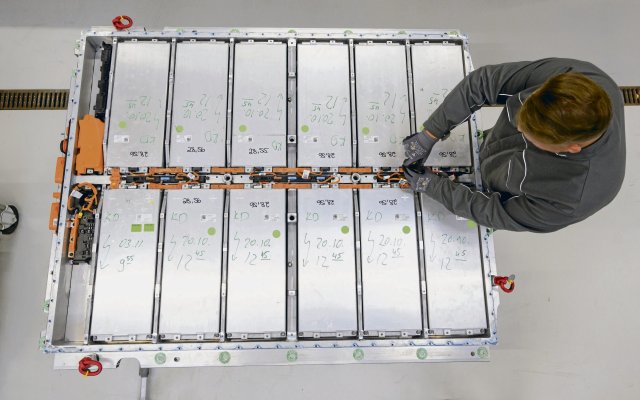Used electric car batteries can still be useful off the road.
Photo: dpa/Julian Stratenschulte
Almost 49 million cars are currently on Germany’s roads – according to the Statista database, there have never been more since the surveys began in 1960. In comparison, the proportion of purely electrically powered vehicles is around 1.3 million electric cars quite modest. Still, one should add. The “electric vehicles” have recently increased significantly in terms of new registrations. This year the rate is already 19 percent; Research projects assume that a share of 70 percent is feasible by 2030 – and 100 percent is even considered realistic for 2035.
Against this background, the “Fluxlicon” research project was founded two years ago, a sustainability project in which the Berlin Agency for Renewable Energy (AEE), among others, is involved. “Fluxlicon” stands for “Intelligent and flexible system for the use of any second-life batteries in the municipal charging infrastructure”. To put it more simply: The project, which is funded by the Federal Ministry of Economics, is looking for new places to use old electric car batteries. According to AEE, possible options include charging stations for electric cars, neighborhood networks in smaller communities and emergency power generators in hospitals.
What is also being examined and researched is how well electric car batteries are suitable as a storage medium in the long term. “In Germany, around 1.4 percent of renewable electricity was curtailed in 2022,” says Dr. Robert Brandt, Managing Director of AEE. This means that this share could not be fed into the electricity grid because it was already at capacity at some times. “Such feed-in management measures are necessary when parts of the power grid are so overloaded that the electricity cannot be transported to consumers,” says Brandt. “As a society, we simply can no longer afford to lose renewable electricity in this way.”
The “Fluxlicon” project is currently working with eight model cities and municipalities in Germany that are trying out the use of “second-life batteries”. Hamburg is one of them, three others are in Lower Saxony, three in Baden-Württemberg and one in Bavaria. The Lower Saxony city of Wolfenbüttel, for example, wants to decouple its sewage treatment plant from the power grid and in future operate it with electricity stored in former electric car batteries. Background: As the city’s largest energy consumer, the wastewater treatment plant is intended to function independently in the future – in conjunction with a photovoltaic system – and in this way relieve the burden on the city’s power grid. Furthermore, according to the AEE press release, the newly developed concept would “not only increase the wastewater treatment plant’s own use of electricity, but also enable it to be operated with renewable electricity in times of lower production.”
Only two of the eight model municipalities are currently eligible as “test partners”. According to the AEE, a decision will be made this year as to what these will be. The “Fluxlicon” project will run until the end of 2024, after which a detailed evaluation is planned.
Although the proportion of electric cars in new registrations has increased so much in recent years, the recycling of used batteries is still in its infancy. There is currently no “used market”. Instead, the batteries are passed on directly by the manufacturing companies, which apparently makes procurement much more difficult. There also seems to be a lack of clear regulations regarding warranty, product liability and delivery security.
Most electric car batteries are not compatible with each other due to different manufacturers. At least this problem has now been solved with the help of “Fluxlicon,” according to AEE press spokeswoman Anika Schwalbe: “By using different e-car batteries from different manufacturers or vehicle types, we are helping to extend their useful life,” says Anika Swallow. “If the capacity of the e-car batteries is too low to continue to be used in e-cars, they can be used as stationary storage devices, provided they remain technically intact and functional.” Typically, e-cars would -Batteries replaced when capacity is below 80 percent.
Today’s electric car batteries generally work according to the lithium-ion principle. Lithium is a light metal that can store a lot of energy. In addition, self-discharge is extremely low at an average of one to two percent per month. The disadvantages: Lithium is expensive and highly flammable because it can react with both air and water. Therefore, modern batteries always have a particularly stable casing. Cell sensors monitor composition and temperature, and a safety valve ensures the necessary pressure equalization if necessary. Current electric car batteries weigh 200 to 750 kilograms. Nowadays, even long-distance travelers no longer need to be afraid of their electric car breaking down on the open road: the record is currently 770 kilometers driven on a single charge.
If well cared for, the rolling energy storage devices can last for 2,000 to 3,000 charging cycles – that corresponds to a service life of around ten years. To protect batteries, they should always have a medium charge level (30 to 70 percent). Anyone who has filled up their electric car is well advised to drive off straight away.
Become a member of the nd.Genossenschaft!

Since January 1, 2022, the »nd« will be published as an independent left-wing newspaper owned by the staff and readers. Be there and support media diversity and visible left-wing positions as a cooperative member. Fill out the membership application now.
More information on www.dasnd.de/genossenschaft
